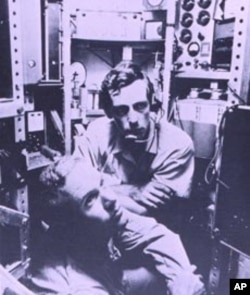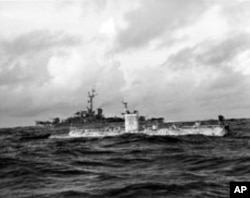In 1960, a U.S. Navy submersible craft, called the Trieste, plunged almost 11 kilometers to the deepest part of the Pacific Ocean off the coast of Guam.
For more than 50 years, that pioneering record in ocean exploration has not been broken.
Now, explorer and film director James Cameron, who won an Academy Award for the motion picture "Titanic," is repeating that record-setting journey. He's doing it solo, in a unique, torpedo-shaped submersible, a one-person craft he helped design with a team of engineers over the past eight years.
Unlike most submersibles, the tiny sub is oriented vertically. And it uses lighter materials like super-strong structural foam to improve buoyancy and to withstand the enormous deep-sea pressures.
Cameron hopes to unlock a few more mysteries about life at the ocean bottom.
"We know very little about the species that live down there," Cameron says. "We know little about the distribution of the biological communities. We don't know know how these animals have adapted to this unbelievable pressure that exists down there."
Cameron will film and collect samples on the seafloor for about six hours before returning to the surface.
Going deeper than Mt. Everest is high
Cameron's mission will owe much to that pioneering dive, more than a half-century before, by the crew of the Trieste.
When co-pilot Donald Walsh first saw the Trieste on a flat barge in San Diego, California, more than 50 years ago, he wasn't impressed. "It looked like an explosion in a boiler factory. And I looked down at all these bits and I thought, 'Good luck to them.' I couldn't make any sense of it."
What Walsh, then a Navy lieutenant and aide to the commander of a fleet of submarines, didn't know at the time was that he would co-pilot the Trieste.
The mission would advance ocean science by taking the craft to the ocean floor at a depth of 11,000 meters - deeper than Mt. Everest is high.
"That was more than 10 times deeper than I had ever been in a submarine," he says. "Most oceanographers don't like excitement and adventure. They want a very stable, reliable, well-known platform. What better demonstration of the safety of this platform than to go to the deepest place in the ocean and come back perfectly intact and in working order?"
The Trieste is a bathyscaphe - a free-diving self-propelled submersible - one of just two in the world in the late 1950s. It is an impressive craft at over 16 meters long with a gasoline-filled flotation chamber's deck, rails, and conning tower that make it look a bit like a submarine.
"Basically, it's an underwater balloon," Walsh says.
"You've got two parts to it: You've got the balloon - which is (a) long cylindrical object - and that's filled with a lighter-than-water substance, which is aviation (grade) gasoline. Oil floats on water, and so you get the buoyancy or lift. Then beneath the balloon you have a cabin for the fragile humans."
That cabin is a 14-ton spherical steel capsule only two meters in diameter, with a single, half-meter-wide circular plastic window for viewing. There is just enough room for two people.
On Trieste's historic dive, the co-pilots would be Walsh and Swiss scientist Jacques Piccard - whose father, Auguste Piccard, had designed the craft.
In late December 1959, Walsh recalls, he and Piccard headed to Guam to begin a series of test dives. "By the time we got to January 1960, we were pretty familiar with the workings of the submersible."
The descent
On January 23, 1960, the Trieste began its mission in rough seas. It descended cautiously through bioluminescent particles and ocean layers of gray, then black, at about one meter per second. Things went smoothly until the Trieste was nine-and-a-half kilometers down, when they heard a muted bang.
"It got our attention," Walsh says. "But we didn't know at the time what it was. We just knew that we were alive and everything was functioning well. All of our instruments and indicators said the dive was progressing just fine. So we proceeded."
That bang turned out to be a crack in the Plexiglas viewing window. Luckily, it didn't leak and the Trieste arrived, intact, at the deepest point in the Pacific Ocean's Mariana Trench - a ravine called Challenger Deep. Their descent had taken 4 hours and 48 minutes.
"Just before we landed we saw a flat fish, about a foot long like a halibut or a sole." he says. "That's a bottom dwelling creature. They live on the sea floor and it was a fairly high order marine vertebrate. So that was important to see."
But the landing churned up so much sediment that the 20 minutes the aquanauts spent on the ocean floor was, as Walsh describes it, "like swimming in a bowl of milk."
The Trieste ascended safely, completing the round-trip mission in just over eight hours.
New era in ocean exploration
By the end of that day, the copilots were being heralded as heroes who had opened a new era of ocean exploration.
Both men remained active for decades in ocean exploration. Jacques Piccard died in 2008 at the age of 86.
Walsh says the Trieste produced a blueprint that others would follow. "Everything we did here was a first, not because we were pioneers or inventors, but because literally, necessity is the mother of invention. If we needed something, we had to invent it."
That state-of-the-art technology included underwater lights, cameras, motors and electrical systems.
Remote voyages
Decades would pass before other attempts were made. In 1995 a remotely-operated Japanese vessel reached the site. And in 2009, an unmanned submersible named Nereus, a project of the Woods Hole Oceanographic Institution, made the same journey.
"That was really a first class piece of engineering," says Walsh. "It not only went down there, not just setting a record, if you will, but it did useful work."
Nereus recorded video and collected geological and biological samples with its manipulator arm. In similar fashion, the manned submersible known as Alvin has also expanded our reach into the ocean's inky depths, most famously in its historic visits to the 73-year-old wreck of the Titanic, discovered in 1985 at the bottom of the North Atlantic by ocean explorer Robert Ballard.
But no human has returned to that deepest part of the ocean. If his journey is successful, explorer and filmmaker Cameron will be the first person to do so since Walsh's team did it more than 50 years ago.











